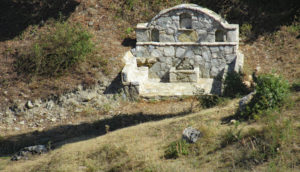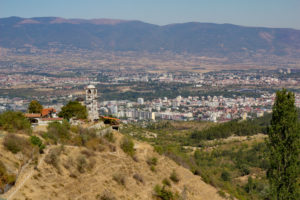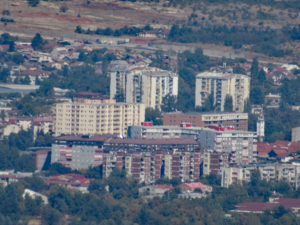Having spent a morning sightseeing in the North Macedonian capital, “Skopje”:https://www.silvertraveladvisor.com/review/attraction/203391-review-sightseeing-in-skopje-part-1-the-old-town, we asked our driver if we could take the Cable Car up to Mount Vodno for what were said to be splendid city views.
We drove up a narrow, winding, steep road out of the city and found a car park closed by a barrier. Unfortunately, our Albanian driver was unable to determine why we couldn’t use the cable car, but the barrier remained firmly down, even after a small ‘incentive’ was proffered.
Instead it was suggested we visit the nearby 12th century Byzantine Pantelejmon Monastery, which we found nestling amongst trees, in the nearby village of Gorni Nerezi. Having paid €2 each, we entered the church as a group were leaving and were approached by a monk clad in black, who asked if he could help. He was a mine of information and told us the church was built in 1164 by ‘Prince Angel’ who had five children: our Bradt guidebook said this was Aleksij (Angelus) Komen, the grandson of the Byzantine Emperor Alexios Komenos I. One child was very sick but recovered, so the church was built and dedicated to Saint Pantelejmon, the patron saint of physicians.
We heard that the central cupola had collapsed and had to be rebuilt. The first two levels of frescoes were from the 12th century, with the ones above being from the 16th. The latter were in very early renaissance style when emotion was beginning to be shown in faces. The monk pointed out a scene where angels and Mary were crying and another of Jesus on the cross, with Mary and John the Baptist not just stood at his side as was usual but were touching and helping him.
Having visited several Orthodox Churches during our tour of the Balkans, I realised there was no iconostasis and was told that under the communist era, the monastery area was turned into a restaurant and the church a museum. The monks had returned only three years ago. Although there were two new and modern icons at either side of the space where the missing iconostasis, the monk said they were trying to build up the icons as and when funding allowed.
We were told there were five cupolas to demonstrate the five wounds of Christ and in each was a fresco of Jesus at a different age. He led us into two small towers at the front of the church, so we could look up at the frescoes. In the first was a grave, whilst in the other, the Monk was kind enough to help me onto the high ledge so I could enter the tower.
The Monk then gave us some time to look around on our own, but when we tried to find him to offer our thanks for his help and kindness, he’d disappeared.
Unfortunately, photographs were not allowed inside, but we did take advantage of being on our own to take a quickie.
Before leaving, we strolled around the grounds, replete with beehives and mountain spring, and got our photos of the city from a large viewing area – no need for the cable car.










